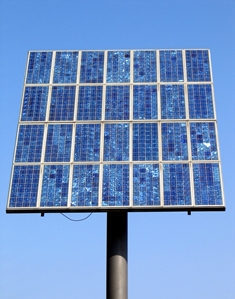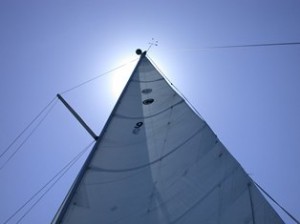I have always been very interested in solar energy. The sun is a very powerful resource of which we, as a planet, are simply not taking full advantage. A few years ago I calculated the equipment needed to supply 100% of the electricity requirements by my home. The cost was rather astounding and enough for me to drop the idea (something around $30,000). When I compared this cost to the $60-$70 that I was paying to the electric utility each month, it was simply not worth it. The “need” for electricity on my boat has caused me to re-investigate solar. I have been pleased to find that the cost of photovoltaic cells (electricity producing solar panels (solar cells)) has decreased (significantly) and the output has increased.
 My boat has one 80 watt panel, an older style regulator/charge controller, and battery bank consisting of four Group 27 batteries (12 Volt – total capacity of about 400 amp hours). A 12 volt battery requires a charging voltage of about 14 volts. At this voltage, my 80 watt solar panel will put out about 5.5 amps. This is based on Watt’s Law which states that watts = voltage x amperage. So, 80 watts divided by 14 volts equals 5.7 amps. The south Florida area is documented as providing about 6 Sun Hours per day. Sun Hours are important as a solar panel does not produce full output from dusk to dawn or when there is cloud cover (and so forth). What this all means is that my solar panel will produce about 35 amp hours per day. Obviously, this is a rough calculation and depends on sky cover among other variables. To know if this is enough, I must know how much power I will consume each day.
My boat has one 80 watt panel, an older style regulator/charge controller, and battery bank consisting of four Group 27 batteries (12 Volt – total capacity of about 400 amp hours). A 12 volt battery requires a charging voltage of about 14 volts. At this voltage, my 80 watt solar panel will put out about 5.5 amps. This is based on Watt’s Law which states that watts = voltage x amperage. So, 80 watts divided by 14 volts equals 5.7 amps. The south Florida area is documented as providing about 6 Sun Hours per day. Sun Hours are important as a solar panel does not produce full output from dusk to dawn or when there is cloud cover (and so forth). What this all means is that my solar panel will produce about 35 amp hours per day. Obviously, this is a rough calculation and depends on sky cover among other variables. To know if this is enough, I must know how much power I will consume each day.
I do not have exact power consumption data on a number of items but I think the following is close. It should be noted that I do not have refrigeration (yet) and the use of LED lighting offers a very significant decrease in electrical consumption over incandescent lighting. My 110 volt power inverter and laptop use is one area in which I have very little actual data.
Anchored/Moored:
- Anchor Light (LED): .25 amp x 12 hours
- Cabin Lights (LED): .25 amp x 4 hours
- Stereo: 2 amps x 3 hours
- Laptop: 5 amps x 3 hours
- Fans: 2 amps x 6 hours
Underway (Day):
- VHF Radio: 1 amp x 12 hours
- Autopilot: 2 amp x 12 hours
- Chartplotter: .5 amp x 12 hours
Underway (Night):
- Running Lights (LED): .5 amp x 12 hours
- Steaming Light (LED): .5 amp x 12 hours
- VHF Radio: 1 amp x 12 hours
- Autopilot: 2 amp x 12 hours
- Chartplotter: .5 amp x 12 hours
- Cabin Lights (LED): .25 amp x 4 hours
Using the above information:
- I will consume about 40 amp hours in a day while anchored.
- I will consume about 100 amp hours in a full day of sailing.
- I will consume about 60 am hours in a full day that includes being underway for six hours.
From the above we can see that my 80 watt solar panel should provide a balanced or self-sufficient condition when anchored (putting about as much into the battery as I am taking out). When underway, this changes due to the use of some high load equipment (namely the autopilot and VHF radio). This is pretty good and I plan to be satisfied with this for a while as I can always motor sail for a bit and use the engines alternator to replenish the batteries.
My options at this point are to accept what I have, add another solar panel to ensure I always have enough electricity, or increase the efficiency of the solar panel that I have. The latter option can be done very inexpensively by replacing the existing charge controller with a modern, more intelligent unit.
I have elected to go with a SunSaver SS-MPPT-15L charge controller. MPPT (Maximum Power Point Tracking) is relatively new technology that (layman speak) alters the power coming from the solar panels into the most useable form for the battery bank. As I understand it, the controller can increase the voltage while reducing amperage OR decrease the voltage while increasing the amperage. It does this based on the output provided by the panels and the demand of the battery/load. I am not an EE so I do not claim to fully understand the details but the bottom line is more efficient use of the solar panel output. A nice perk is that the MPPT controllers take better care of the battery by using the appropriate type of charge depending on the state of the battery. This prevents over-charging of the batteries and, hopefully, extends their life.
For those researching the subject, here are a few links that I found very helpful:
Dan’s Solar Power on Boats


This is Dan, and I’m glad you find the article I wrote helpful.
One thing I would highly recommend, since it doesn’t appear to be mentioned above is installing a battery monitor. A good battery monitor, like the Victron BMV 601, can pay for itself in relatively short order by helping you optimize the boat’s charging setup, battery bank size, and give you a very accurate idea of what your actual real-time usage and charging. The VIctron unit is about $175 or so, and a very worthwhile addition to your boat’s electrical system.
As for refrigeration, I use and recommend the Engel line of small refrigerators. They’re fairly energy efficient and have always been highly regarded in the Practical Sailor reviews of refrigerators. Most are dual power source and will kick over to 110 VAC if shorepower is connected, and fall back to 12 VDC otherwise.
Regards,
Dan Kim
Hi Dan, Thanks! I completely forgot about a good battery monitor. Brittany & Scott very favorably list the same monitor in their Windtraveler blog.
I admit that I have not spent any serious time researching refrigeration. I’ve researched enough to see the options and the costs and the latter keeps driving me away. I REALLY like the Engel approach (no modifications required to the boat) but also like the keel cooled approach of not putting warm/hot air into the cabin. I’m sure one of these days this will rise up the priority list and I’ll have to get serious. Thank you for the positive input on the “portable” option!